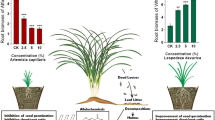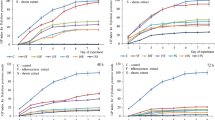Abstract
A unique pattern of weed exclusion was found under the canopy ofDelonix regia, which was planted in many places as an ornamental tree in the south of Taiwan. A quadrat method was employed to examine the botanical composition between the area underneathD. regia and its adjacent control grassland. The number of species and coverage of understory species were significantly lower in the area of theD. regia than that of the grassland, indicating the growth of understory species was suppressed byD. regia. A series of aqueous extracts of leaves, flowers, and twigs ofD. regia were bioassayed against three species to determine their phytotoxicity, and the results showed highest inhibition in the flowers. A water-culture experiment indicated the aqueous extract of flowers ofD. regia on two local understory species (Isachne nipponensis andCentella asiatica) inhibited growth of both species by more than 70%. The phytotoxicities of fallen leaves and flowers ofD. regia were not significantly affected by temperature. When the plant material was subjected to temperatures above 70°C, however, phytotoxicity was decreased, indicating that the allelopathic nature ofD. regia could easily be decomposed by fire. By means of paper, thin-layer, and high-performance liquid chromatography, and UV-visible spectrophotometry, responsible phytotoxins present in leaves, flowers, and twigs ofD. regia were identified as 4-hydroxybenzoic, chlorogenic, 3,4-dihydroxybenzoic, gallic, 3,4-dihydroxycinnamic, 3,5-dinitrobenzoic, and L-azetidine-2-carboxylic acids, and 3,4-dihydroxybenzaldehyde. The findings of bioassays and the number and amount of responsible allelopathic compounds found inD. regia are well correlated, thus permitting the conclusion that the exclusion of understory plants under the canopy ofD. regia trees was due primarily to the allelopathic effect of the fallen flower, leaves, and twigs of theD. regia. A possible mechanism of action is discussed.
Similar content being viewed by others
References
Ather, M., andMahmood, A. 1980. A qualitative study of the nodulating ability of legumes of Pakistan. List 2.Trop. Agric. (Trinidad) 57:319–324.
Casinovi, C.G., Ceccherelli, P., Fardella, G., andGrandolini, G. 1983. Isolation and structure of a quassinoid fromAilanthus glandulosa.Phytochemistry 22:2871–2873.
Chou, C.H. 1973. The effect of fire on the California chaparral vegetation.Bot. Bull. Acad. Sin. 14:23–34.
Chou, C.H. 1992. Allelopathy in relation to agricultural productivity in Taiwan: Problems and prospects, pp. 179–204,in S.J.H. Rizvi and V. Rizvi (eds.). Allelopathy: Basic and Applied Aspects. Chapman & Hall, London.
Chou, C.H., andChung, Y.T. 1974. The allelopathic potential ofMiscanthus floridulus Bot.Bull. Acad. Sin. 15:14–27.
Chou, C.H., andKuo, Y.L. 1986. Allelopathic research of subtropical vegetation in Taiwan III. Allelopathic exclusion of understory byLeucaena leucocephala (Lam) de Wit.J. Chem. Ecol. 12:1431–1448.
Chou, C.H., andLee, Y.Y. 1991. Allelopathic dominance ofMiscanthus transmorrisonensis in an alpine grassland community in Taiwan.J. Chem. Ecol. 17:2267–2281.
Chou, C.H., andLin, H.J. 1976. Autointoxication mechanism of Oryza sativa I. Phytotoxic effects of decomposing rice residues in soil.J. Chem. Ecol. 2:353–367.
Chou, C.H., andMuller, C.H. 1972. Allelopathic mechanisms ofArctostaphylos glandulosa var.zacaensis.Am. Midl. Nat. 88:34–347.
Chou, C.H., andWaller, G.R. 1980. Possible allelopathic constituents ofCoffea arabica.J. Chem. Ecol. 6:643–654.
Chou, C.H. andWaller, G.R. (eds.). 1989. Phytochemical Ecology: Allelochemicals, Mycotoxins, Pheromones and Allomones. Institute of Botany, Academia Sinica Monograph Series No. 9. 535 pp.
Chou, C.H., andYang, C.M. 1982. Allelopathic research of subtropical vegetation in Taiwan II. Comparative exclusion of understory byPhyllostachys edulis andCryptomeria japonica.J. Chem. Ecol. 8:1489–1507.
Chou, C.H., andYao, C. 1983. Phytochemical adaptation of coastal vegetation in Taiwan I. Isolation, identification and biological activities of compounds inVitex negundo.Bot. Bull. Acad. Sin. 24:155–168.
Chou, C.H., andYoung, C.C. 1974. Effects of osmotic concentration and pH on plant growth.Taiwania 19:157–162.
Chou, C.H., andYoung, C.C. 1975. Phytotoxic substances in twelve subtropical grasses.J. Chem. Ecol. 1:183–193.
Ghouse, A.K.M., andHashmi, S. 1977. Comparative study of cambial structure of five India tropical trees.Phytomorphology 0:35–36.
Gill, L.S., andHusaini, S.H. 1982. Cytology of some arborescent Leguminosae of Nigeria.Silvae Genet. 31:117–122.
Gomez, K.A., andGomez, A.A. 1976. Statistical Procedures for Agricultural Research with Emphasis on Rice. IRRI, Los Banos, Laguna, Philippines, 294 pp.
Heisey, R.M. 1990a. Evidence for allelopathy by tree-of-heaven (Ailanthus altissima).J. Chem. Ecol. 16:2039–2055.
Heisey, R.M. 1990b. Allelopathic and herbicidal effects of extracts from tree of heaven (Ailanthus altissima).Am. J. Bot. 77:662–670.
Hodges, C.S., andTenorio, J.A. 1984. Root disease ofDelonix regia and associated tree species in the Mariana Islands caused byPhellinus noxius.Plant Dis. 68:334–336.
Leu, L.L. 1991. The allelopathic potential ofDelonix regia (Boj.) Raf. MS thesis. National Taiwan University Taipei, Taiwan.
McPherson, J.K., andMuller, C.H. 1969. Allelopathic effects ofAdenostoma fasciculatum. “Chamise” in the California chaparral.Ecol. Monogr. 39:177–198.
Rice, E.L. 1984. Allelopathy, 2nd ed. Academic Press, New York. 422 pp.
Sung, M.L., andFowden, L. 1969. Azetidine-2-carboxylic acid from the legumeDelonix regia.Phytochemistry 8:2095–2096.
Tang, C.S. 1986. Continuous trapping techniques for the study of allelochemicals from higher plants, pp. 113–131,in A.L. Putnam and C.S. Tang (eds.). The Science of Allelopathy. John Wiley & Sons, New York.
Waller, G.R. (ed.) 1987. Allelochemicals: Role in Agriculture and Forestry. ACS Symposium Series 330. American Chemical Society, Washington, D.C. 606 pp.
Wang, T.S.C., Yang, T.K., andChuang, T.T. 1967a. Soil phenolic acids as plant growth inhibitors.Soil Sci. 103:239–246.
Wang, T.S.C., Cheng, S.Y., andTung, H. 1967b. Extraction and analysis of soil organic acids.Soil Sci. 103:360–366.
Author information
Authors and Affiliations
Additional information
The study was supported by grants to C.H. Chou awarded by the Academia Sinica, Taipei, and the National Science Council (NSC-80 & 81-0211-BOO 1-25) of The Republic of China.
Rights and permissions
About this article
Cite this article
Chou, CH., Leu, LL. Allelopathic substances and interactions ofDelonix regia (Boj) Raf. J Chem Ecol 18, 2285–2303 (1992). https://doi.org/10.1007/BF00984951
Received:
Accepted:
Issue Date:
DOI: https://doi.org/10.1007/BF00984951




